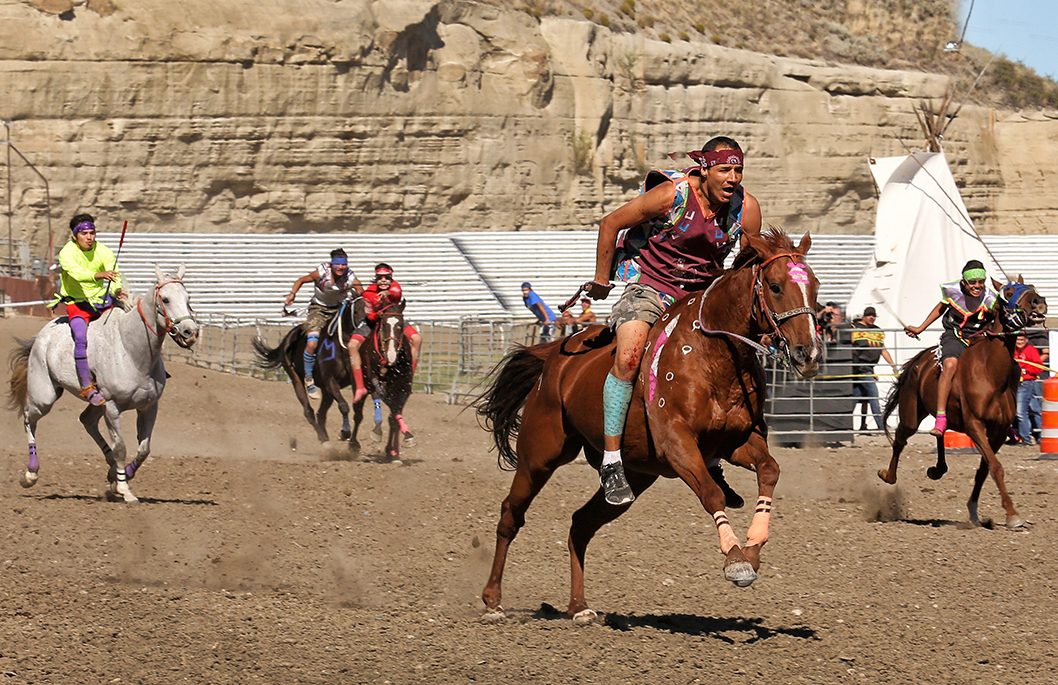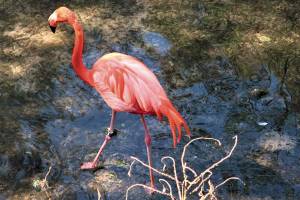America’s oldest known competition, Indian Relay, has revived to become the world’s newest extreme sport. This race involves five or six Native American warriors in traditional regalia, racing around a track, bareback, leaping from one galloping horse to another. They race in the spirit of native pride and for bragging rights for the individual, his team, and their nation.
Calvin Ghost Bear, from the Pine Ridge Reservation in South Dakota, is on the board of the Professional Indian Horse Racing Association (PIHRA). He says the relay is unlike other sports.
“The heart pounding, the hooves, the adrenalin, the crowd, the excitement – you aren’t going to get that anywhere else.”
The PIHRA hosts the 2016 All Nations Indian Relay Championships at MetraPark in Billings, September 22-25, 2016. The Championships are the culmination of 17 grueling competitions held June until September in Wyoming, Washington, Oregon, Idaho, Montana, South Dakota, and Canada. Tribes represented in the relay include Oglala Lakota Sioux, Lower Brule Sioux, Eagle Butte Sioux, Northern Cheyenne, Blackfeet, Crow, Shoshone-Bannock, Eastern Shoshone, Nez Perce, Nakota, the Colville Confederated Tribes, and the Umatilla Confederated Tribes. During these qualifying races, PIHRA member teams earn points that lead them “on the road to Billings” and the chance to compete with the best of the best. Some describe it as the Super Bowl or World Series of Indian Horse Relay.
The Horse Nations of the old order developed the relay separately within their various tribes as a way of sharpening their skills as horsemen. On a buffalo hunt, they may have exchanged horses in a hurry to keep up with the herd. In battle, they needed to be off one horse and on to a fresh one in a flash. These skills would help them catch wild ponies to increase their wealth and prestige.
Indian Relay is a team competition comprising one rider, three horses and three courageous teammates to hold, catch, and control the two extra horses as the rider leaps from one to another. In effect, the rider is the relay “baton” passed from one racing horse to the next. Each horse makes a single circuit of the track. Teams execute these extremely difficult bareback transfers by stopping 1,200-pound horses from a full gallop, and starting others all within a crowded stretch of track filled with other teams performing the same maneuvers. Thrilling chaos describes the rush of animals and brightly dressed warriors working at breakneck speed to get ahead of the competition.
Ghost Bear says the relay is attractive to Native American boys who grow up on reservations. Most have access to horses and have tried some of the skills. They pride themselves on being horsemen and on becoming one with their horse. He calls the drive to do their best the warrior spirit in them.
“You want to compete with other nations, you want to win. You want to bring pride to the team and honor to your nation.”
Ghost Bear witnessed the sport from the time he was a young teen. It was a low profile competition at powwows, fairs, and rodeos on the Pine Ridge and other nearby reservation. In 2012 that began to change, when the Professional Indian Horse Racing Association (PIHRA) formed. Since then, the number of PIHRA teams has more than doubled and no one knows how many more teams there are not associated with PIHRA.
Good changes happened as the race gained recognition. Race times keep getting better and better, teams learn to plan, budget, and solicit sponsors. The young men discover how to get themselves, their team, and their horses to each race.
Ghost Bear, at 51, no longer participates on a team, but advises his son’s team, the Lakota Warpath Indian Relay Race team. However, each team develops its own secret methods, which may include anything from what they feed the horses to what they do post-race to get that split second advantage over their competitors.
Ghost Bear looks forward to going to Billings with its long-standing tradition of horseracing and a beautiful racetrack. His family ran horses there when it was a venue for traditional horseracing, and he already has good memories of winning there. He expects a crowd that is even bigger than the one last year for the All Nations Indian Relay Championships.
“In Billings, we’ll meet some old friends, and create some new relationships that last a long, long time,” he says.
Why should you attend?
“The Indian Relay reflects one group of people in this nation that we live in,” replies Ghost Bear. “People need to be there to witness this.”
Tickets for the 2016 All Nations Indian Relay Championships are on sale via letsrelay.com or the MetraPark ticket office at 800-366-8538. MSN










